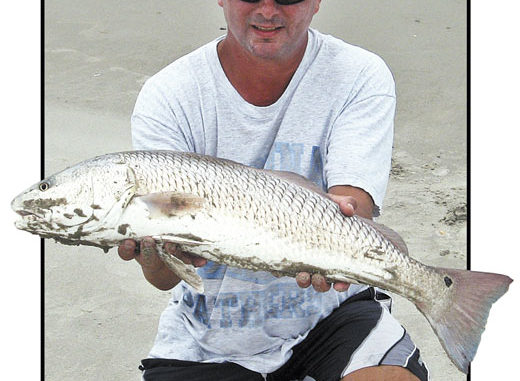
Camping on Bear Island is the ticket for great fall fishing in surf and backwaters.
The 3-mile paddle from the mainland to Bear Island couldn’t have been any easier. The tide was falling, with just a slight breeze blowing out — the forecast excellent for the entire camping trip. Rod Carroll of Emerald Isle and his son, “little David” headed up the narrow “kayak trail” that leads to a long cut on the north end of the island and the string of campgrounds along the beach, trying to make the trip in time to set up camp and fish the backwater before dead-low tide.
Two good friends and fishing rivals, Chip Brackin of Greensboro and David Greiner of Wilmington, were trolling along the kayak trail, casting Berkley Gulps in hopes of picking up a flounder or redfish on the way out. Another three guys were coming later — they’d better remember to bring ice.
The October expedition was an annual outing, an all-guys’ trip to one of the best-kept secrets on the East Coast. It’s not the easiest place to do a 4-day camping trip, but after 10 years, these guys can probably do it better than most. Many were using kayaks to fish the tidal marshes long before kayaking became popular, and they have learned from trial-and-error what to leave home when camping on Bear Island.
A Cajun Thunder cork trailing a gold Gulp! shrimp landed near an island of oyster rock with a splash.
“You’re going to scare off every fish in here with that thing,” Greiner complained, half-seriously, from his red Pungo kayak.
The words were barely out of his mouth when a wake appeared and a nice redfish rolled on the lure. The fish made several nice runs before being netted. Twenty yards down the trail, Greiner caught the red’s twin on a Gulp! minnow fished on a leadhead jig.
Fifteen minutes old, and the trip had already produced a pair of 24-inch redfish for the dinner menu.
After catching a few more puppy drum and flounder, the work began: setting up camp — trying to finish before pitch-black dark. The rest of the crew rolled in late, with coolers full of ice and dinner — Greiner’s wife, Fran, prepared a wonderful tinfoil pot roast that he took credit for because he hauled it over in his cooler — and stories of redfish waking all over the backwater in the waning light. Story-telling ensued, with past trips relived, the fish getting bigger and conditions getting tougher with every telling.
The next day, the cut produced redfish between 23 and 25 inches, plus nice flounder, with the best fishing just as the tide began to fall. Greiner got drum bites on eight straight casts, with every fish in the 18- to 27-inch slot. The backwater is renowned for great flounder fishing; the reds are thick everywhere. That spawned great expectations for the surf fishing, because the fish are always larger there.
Bear Island is a surf fisherman’s dream-come-true. A sandbar runs the length of the beach, with fertile water on either side. It’s close enough in places that it can be cast over. Brackin and his cousin, Ben Brackin of Level Cross, along with Steve Tyler of Wilmington and one of the trip’s “rookies” — Dave Schlosser of Greensboro — caught slot-sized and oversized reds in pairs in the surf the directly across the dunes from camp. When the action really picked up, it was in front of the next campground down the beach.
The whooping and hollering was clearly audible, and it wasn’t difficult to see fishermen with bent rods in hand. The action was so heavy, the opinion was that bluefish had to be involved, but when the marine patrol arrived and started measuring fish, all questions are answered; more redfish. A giant school had set up shop outside the sandbar directly in front of that campsite, with fish between 27 and 30 inches biting on almost every cast.
After 30 minutes of painful observation, Brackin and company finally headed in that direction, asking permission to join in on the fun, but the reds were already moving north and out of casting range. Boats set up on the outside of the sandbar, and a half-dozen surf fishermen hooked up at once, but with the fish moving all the time, the run lasted only 30 more minutes as the tide fell out toward dead low.
Promises were made to return the next day, at least an hour before the high tide.
The next afternoon, with Greiner and several members of his crew catching redfish in front of the campsite, a big school of drum showed up south, down the beach toward the bathhouse. Birds were going nuts, hitting the water in a feeding frenzy of their own.
It was apparent that a strange thing had happened overnight; a tremendous mass of small baitfish — large and thick enough that the school looked big enough to walk on — had shown up in the trough just off the beach. Carroll is hooked up first;
“You got a bluefish?” Greiner asked as the birds moved almost in front of camp.
“Not sure, but Steve caught several nice bluefish up the beach. I don’t think this is a blue.”
When Carroll landed a 4-pound Spanish mackerel, the group broke away, heading for their kayaks to get casting rods and tie on plugs faster than you can say “Got-Cha.”
The action lasted a solid hour, with everyone catching Spanish and blues, hooking up or re-tying after a cutoff. With the sandbar farther off the beach, there was some deep water between it and the shoreline, and the fish were in there thick, gorging on the tiny baitfish and looking like a National Geographic special on piranhas.
Then, all at once, they were gone. The scream of 8-pound test line leaving a small spinning reel announced that a school of 12- to 15-pound redfish had arrived for the cleanup.
“Little” David Carroll hooked up to a fish that hit his Yo-Zuri casting lure, and it peeled off line like a kite in the wind. His 7-foot spinning rod was bent double.
“This isn’t any spanish mackerel,” he said, heading up the beach following his fish.
Schlosser hooked another big fish, so surf rods were grabbed and cut bait was quickly tossed into the fray. Not more than 20 yards from the shoreline, the reds looked like small, gold torpedoes rolling through the swells. With reels screaming everywhere, fishermen from other camps joined up. Refish between 32 and 35 inches came to shore, with fishermen whooping and hollering.
After the redfish moved out, the cycle started again with hoards of 3- to 5-pound bluefish chasing the bait right onto the beach, and Spanish mackerel charging everywhere. At the end of that bite, the big reds showed up again, surf rods were produced, and the fishing frenzy was almost equal to the feeding frenzy. Call it “fishing nirvana.”
Schlosser was asked, “What do you think?”
“I fished the Outer Banks back in the heyday of fall fishing. I fished it back in the 70s when the surf fishing stories were legendary. I believe this tops it. I really do,” he said.
The incredible spectacle of nature lasted for hours. From high tide all the way down, the fish came and went in droves. The fishermen were suddenly aware that their chairs and rod holdlers appeared to be halfway back up the beach toward camp — the tide had fallen all the way out with no one noticing.
Dinner was approaching when the group of fishermen finally left, the vicious miracle of nature still in full swing. A few fish were kept for dinner; the number of fish released being far too high to count.
The campers left with the vicious miracle of nature still going strong. Later that evening, the guys at a neighboring campground reported that the drum bite got even better after dark.
The next day, gear was packed by fishermen still shaking their heads in amazement.
Another incredible trip to The Bear has ended, and prospects of what next year might bring to the table already being
considered.

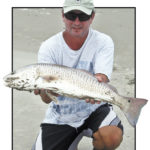
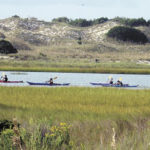
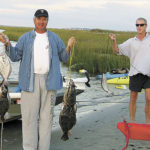
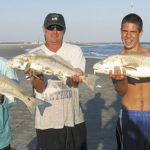
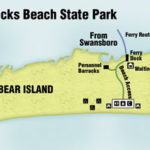


Be the first to comment